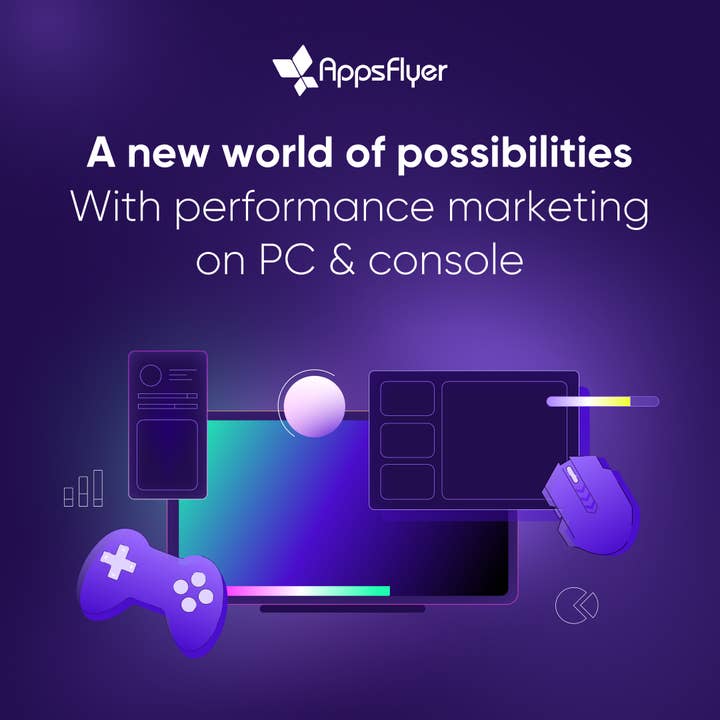How to market console and PC games in a mobile world
Mobile marketing company AppsFlyer on the rise of cross-platform games and why it’s adding console and PC to its marketing and measuring tools
Traditionally, the console and PC gaming markets have operated very differently to mobile. But that’s changing as technological advancements are allowing mobile developers to bring their games to console, and vice versa. Plus, as recent major acquisitions show, console and PC-first publishers are eyeing up the mobile market. Meanwhile, some of the most successful titles are embracing a cross-platform strategy from conception.
To adapt to this new environment, mobile analytics firm AppsFlyer expanded its multi-platform marketing and measurement solution to cover cross-platform expansions from mobile into console and PC, and vice versa.
AppsFlyer’s Director of Product Adam Smart discusses why it’s important that games companies take notice of this and ensure they have all the necessary tools and insights to adapt to this new environment.
How does marketing for mobile games differ from console and PC?
In our experience, there are three different types of games companies: console and PC-first, mobile-first, and hybrids.

Console and PC is an upfront purchase of a game, which has a beginning and end. You play that game, complete it, get bored, and move on to something else. Mobile-first is generally free-to-play, and there isn't an end to these games, as such, with more content added over time. They’re generally monetized through in-app purchases, or in-app advertising.
Then you have the hybrid approach, which is more like Fortnite, Fall Guys, and Rocket League, where they’re on console and PC but they’re a free-to-play model like mobile. They still run on the console principle of having a marketing spend, building that marketing spend until launch, and then the marketing spend sort of tails off somewhat.
So in comparison to mobile, which is constantly driving installs to the game, the marketing for console games is very different in that it generally creates hype before launch, then it launches and the marketing drops off. The main reason for that is that it's very difficult to judge the effectiveness of your spend over time, whereas if you're building up to the launch, you put all of your marketing spend down and you can see the overall results when it launches.
What challenges do mobile-first companies have when expanding to console and PC markets?
For a mobile-first company that has a good understanding of performance marketing, it's very difficult to replicate that model on PC and console because you don’t have that level of visibility on those platforms. It's very difficult to visualize that in a business perspective, and be able to say ‘this is the throughput of users that we would need in order to be revenue-positive’. That's why a lot of the campaigns for consoles are done as a marketing budget rather than a user acquisition (UA) spend. So we’re talking about things like billboards, or ads on the sides of buses, that sort of stuff. It's actually a lot less about performance marketing.
"The marketing for console games is very different to mobile, as it's generally about hype before launch"
For console and PC-first companies, if you saw that the the users that you were getting from an ad had a very high click-to-install threshold, even for a ‘legacy’ game you purchase once, and it has a very strong correlation between somebody clicking that ad and purchasing the game, you know the sources of traffic that are working and where you should be placing ads. That alone would really help fine-tune the marketing budget for console and PC-first companies.
And then you've got the hybrid approach, where you drive traffic for the majority of the time and also have all of the understanding of where to run ads and what performs best, and does that convert to Steam or PlayStation well? These are the questions that companies are trying to work out now. What can we do with the innovation side of running ads? And how does that correlate to the installs that we're seeing on the games?
Why are more companies looking to expand into other platforms or go cross-platform?
I think mobile companies have realized that the revenue coming from consoles and PC is a very high value gamer revenue. Historically, gamers expect to pay somewhere around $50 to $100 to play a game. So I think they're understanding that the potential for revenue to be driven from those platforms is higher than on mobile. Mobile companies have a very strong urge for growth as a whole, so we're starting to see a lot more forays into different areas.
How have console and PC-first companies adopted mobile monetisation strategies for their games and is there not a risk of pushback from their audience?
It's not necessarily the users that dictate the platform, unfortunately. If you look at Diablo 4, it's only playable online, which has changed the games, and the more that companies do that, the harder it is to go back. It becomes the new normal.
Call of Duty has become more popular since it went free-to-play with Warzone. It becomes very, very accessible, and people that wouldn't necessarily have paid the $70 entrance fee are now able to enjoy and play the game. But the fact that you have more users playing the game, you could potentially drive a lot more revenue.
The free-to-play model needs users being sent to it, and you need to acquire those users at a price that means you know the game, on average, will generate x amount of revenue with x amount of users being put through it. Then it's very easy to build a whole business case, and to know that you can scale successfully. That's been a big chunk of the problem on console and PC, it's knowing that you can scale. At the moment, you're essentially flying blind. You have a marketing spend, and then you're looking at what the return for that marketing spend was after the launch. When you look at how mobile companies advertise, and the amount of different sources, the amount of different media partners they work with, it's very difficult to do that on console. So it's very, very difficult to get that clear budget allocation effectively.
How does AppsFlyer’s new marketing and measuring tools help games companies adapt to different markets, whether they’re mobile-first or console and PC-first companies?
"Mobile companies have realized that the revenue coming from consoles and PC is a very high value gamer revenue"
It gives you visibility. So if you were to run campaigns on Google, on Facebook, on Moloco or any of the places that you would be running at the moment for mobile acquisition, it would give you visibility of those installs to PlayStation, to Steam, to Oculus, to whatever gaming platforms you're running on.
Even a console-first company who's running on console that has a one-off standalone game would still be able to run user acquisition to generate installs to get the visibility of how your campaigns are performing. This is very different to the old way of running ads in magazines, on the side of buses, a few digital ads here and there because with those you're not able to get a connection between the ad and the users that installed it. So knowing that the users for this specific ad purchased and being able to see where those users came from helps in understanding your budget allocation.
As lines blur between mobile (free-to-play) and console and PC (premium) platforms, does a cross-platform future also mean adopting more free-to-play models when it comes to monetisation and user acquisition?
That's open for studios to debate over. I think there'll be distinct segregations between AAA titles that do have a beginning and end and live-service games like Call of Duty: Warzone that don't end and have a seasonal approach, with more opportunities to sell battle passes and cosmetic items to generate revenue.
For me, it brings the possibility alive for them to be able to create different games. You get studios that are developing because they have a passion for creating games. At the same time, whether we like it or not, gaming is of course big business. And many of those businesses have shareholders which need to see revenue being generated, otherwise the games stand a strong chance of being shut down.
With the extended visibility AppsFlyer now provides to game developers and studios for acquiring users, we believe games can be built in different, more accessible ways – and ultimately developers are now empowered to experiment with different models. As games become more platform-agnostic, developers have added flexibility in their designs, unlocking innovation, exciting player experiences and new revenue streams.
For more details on AppsFlyer’s new solution, click here.
